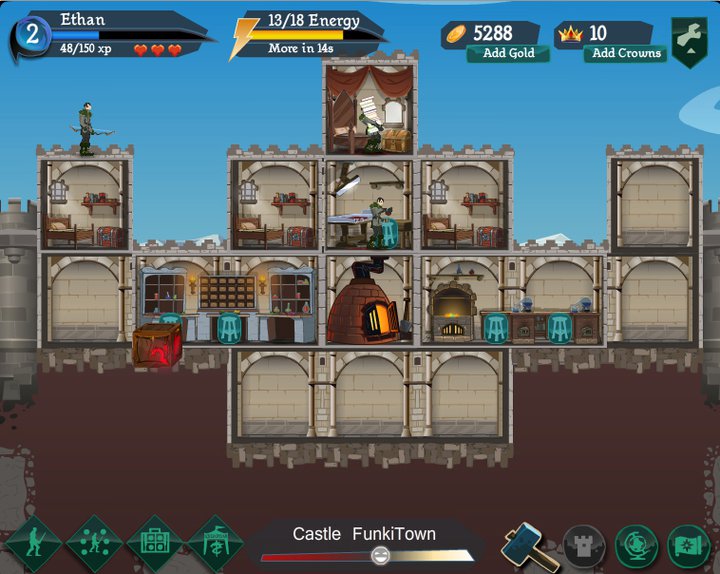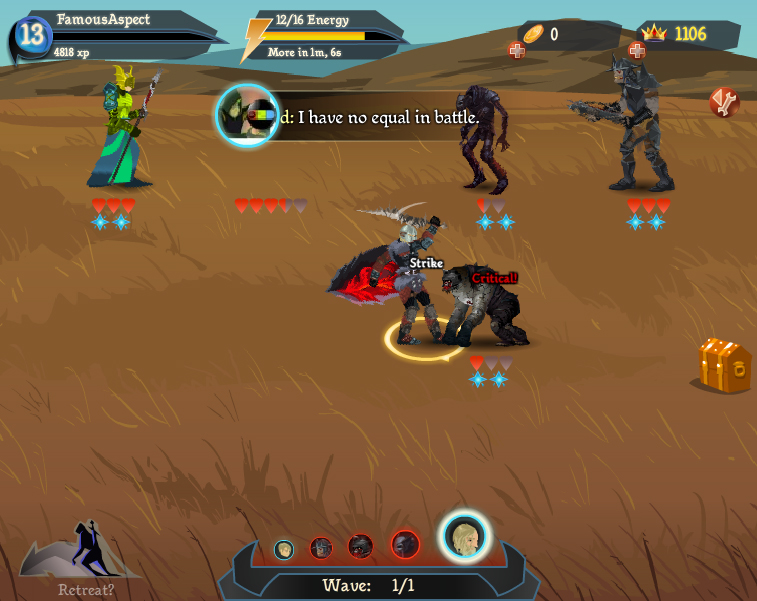My current game, Dragon Age Legends, was released last month. I wrote the following post as designer notes on the upcoming guild system.
One of the design goals of Dragon Age Legends is to have meaningful social mechanics. Many social game are social only in the sense that they use the player’s social graph to help spread the game virally through her network – by encouraging the player to invite her friends as neighbors to grow her farm, for example, or trading items with one another through the gifting system to finish a building. While these mechanics help grow a social game’s visibility, they don’t necessarily make the actual experience of playing the game more fun.
Our core social feature in Legends is borrowing friends’ characters to fight alongside one’s own character in combat. As one’s friends level up their own characters, they make the game more fun by providing new skills and stronger characters to use. Unlike most RPGs, players of Legends will be able to try out the entire skill tree depending on how their friends upgrade their characters. Borrowing a friend’s character also provides that friend with a small gold bonus, which creates some interesting dynamics – encouraging players to have the most appealing characters (to earn more gold) while also giving veterans a charitable reason to bring along low-level friends they want to help.
However, a genuinely meaningful social mechanic can create its own share of problems. Facebook friends are not necessarily one’s actual friends. Players often announce their names and character details in various forums, hoping to find “fake friends” to fill out their list. Doing so creates three advantages. First, the more friends the player has, the more opportunities for his character to be borrowed and thus earn friend gold for the player. Second, high-level friends make combat far easier because of their high stats and upgraded skills.
Finally, a surplus of friends allows the player to bypass the rest time restriction. Borrowed characters enter a rest state after combat finishes for a certain period of time (often for a few hours, depending on the level and damage sustained). This rest period exists so that players will not be able to reuse a single friend’s character over and over again (and, thus, feel no incentive to invite other friends into the game). However, if a player has a huge list of fake friends playing the game, perhaps numbering in the hundreds, this mechanic becomes irrelevant as there will always be a ready supply of fully rested characters.
These three advantages can greatly distort the balance of the game. In particular, if a player has a huge list of high-level friends, which is not difficult if one looks in the right places, the combat becomes trivially easy. High-level characters can wade through most monsters easily, which prevent us from finding an ideal difficulty level. We could boost the strength of all monsters across the board to compensate for endless high-level friends, but that change would ruin the game for the average player who only uses her real friends. Besides, we want the player to experience the power of a high-level friend mowing down waves upon waves of darkspawn from time to time, just not in every battle.
To fix this issue, we are creating a new system – Guilds. A Guild is a select group of 16 friends who are playing Legends. The player can only borrow characters for combat from this group of 16. The composition of a Guild can be changed at any time (as long as the character being removed is not currently resting), so a player is not restricted to whichever friends are first added to the Guild. Also, a new castle room – the Great Hall – will allow players to expand their Guilds.
Guild membership is one-way; I might have my friend Ethan in my Guild, but Ethan does not need to have me in his Guild. However, if we are both in each other’s Guilds, we receive a bonus of a shorter rest time when using each other’s characters. This feature creates some interesting social pressure, forcing players to choose between using their friends with the best characters and using their actual best friends.
From a design perspective, the greatest benefit of Guilds is tuning as we can now balance the game for a single target – a player who has 16 friends, with a mixture of low- and high-level characters. Because rest time is proportional to a character’s level, players might not want to fill their Guild with only high-level character who would often be unavailable.
Ultimately, the player should be making interesting decisions during all parts of the game, including when deciding which friends to use for combat. Perhaps a certain battle looks fairly easy, so a player might want to use a couple low-level friends or maybe to even try it solo. Perhaps a looming boss battle makes the player hesitant to waste his highest-level friend on a normal encounter. With infinite high-level friends, these dynamics disappear, to the detriment of the gameplay.
Moreover, we want players to be interacting as much as possible with their real friends, as these are the most important social bonds tying the player to the game. Guilds encourage this behavior via the reciprocal membership bonus to rest times as well as the simple ability to build a subset of friends most relevant to the player. Guilds are a small but important step towards creating meaningful and balanced social mechanics within Dragon Age Legends.



